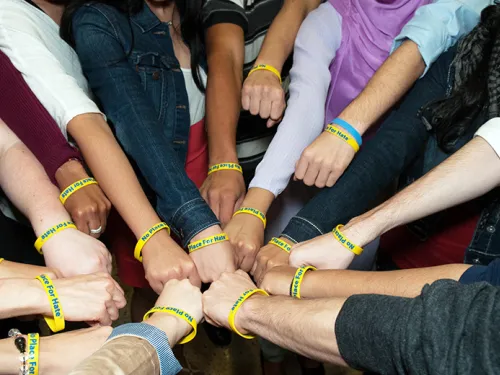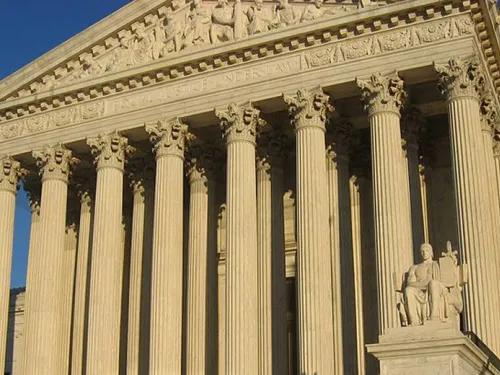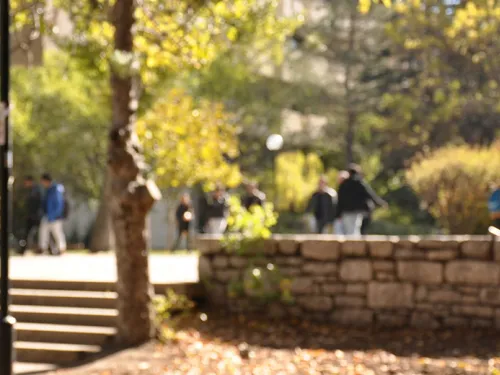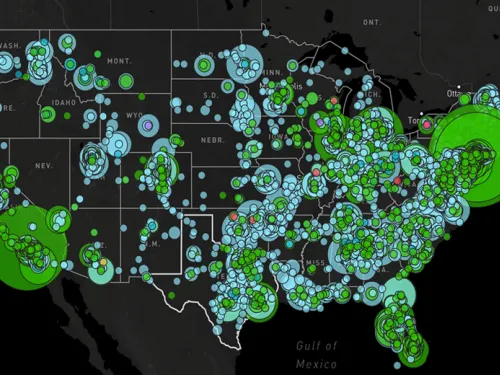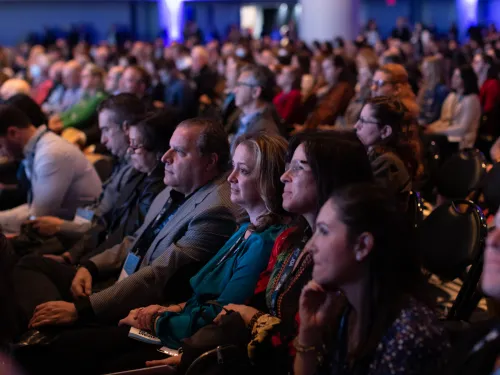
Urge Congress to Protect Students on Campus
Join ADL in urging your Members of Congress to pass the Protecting Students on Campus Act.
Ana Schugurensky, University of California, Irvine
Dr Rachel Shenhav-Goldberg, Tel Aviv University
Independently conducted report, sponsored by ADL
Introduction
The outbreak of campus protest after the Hamas attack on Israel on October 7, 2023, renewed and intensified the long-standing debate over whether social activism that questions Israel’s existence, or that is even critical of Israel, simply masks a new form of antisemitism, and whether Jews, students, faculty or administrators, on campuses confront a particularly hostile environment. Loud protests organized by Students for Justice in Palestine and cognate groups were sometimes accompanied by disruption of academic operations and even sporadic cases of violent conflict. This further raised the question of whether campuses are somehow left-wing “brainwashing” factories and were somehow, either through activism, political uniformity, or classroom politicization, responsible for the rise of a new antisemitism of the left. This is a study of the attitudes towards Jews and Israel among UC students in the weeks before and after October 7th.[1]
Hersh (2024) notes that among Jewish college students, regardless of their “Jewish” upbringing and engagement, the perceived social cost for supporting the state of Israel, participating in Jewish activities on campus, or merely revealing they are Jewish rose significantly between April 2022 and November/December 2023.[2] The lackluster performance of three presidents from Harvard University, Massachusetts Institute of Technology, and University of Pennsylvania before a U.S. House Committee in December 2023, where they appeared to equivocate on the question of whether advocating a genocide against the Jewish people constitutes a violation of the student code of conduct (and the subsequent resignation of two of them) seemed for many to confirm the suspicion that America’s elite universities do not afford Jews the same protections as other minority groups. Others, however, maintained that the concern over campus antisemitism and its relationship to hostility toward Israel are overblown: campus antisemitism remains a minor matter, its relationship to Israel is non-existent, Jewish students’ and faculty sense of isolation on campus is manufactured rather than real, and nothing had really changed in fundamental attitudes toward Jews on America’s campuses after October 7.
The concerns expressed nationally have been especially present at the various campuses of the University of California. At Berkeley, campus tensions came to a head in February 2024 when violent conflict and antisemitic slogans accompanied the invitation to campus of a speaker by a Jewish student organization. At other campuses, normal academic talks on Israel—even those delivered by scholars critical of the current Israeli government—could not be held after October 7 without disruption (and were sometimes transferred to on-line formats). In a March 14, 2024 letter to the University of California Regents, the Anti-Defamation League, California, estimated a 20 fold increase in antisemitic incidents across California over the same period of the previous year.[3] The Amcha Initiative claimed that although a great deal of campus antisemitism stemmed from student organization, “Compared to the same 23-week period last year, we found a staggering increase of more than 1000% (from 8 to 94) in the number of incidents (e.g., lectures, statements, rallies etc.) involving anti-Zionist activism and advocacy carried out or supported by UC faculty and graduate students.”[4]
The relationship of antisemitism to anti-Zionism is, of course, a much older question in the UC system. Reacting to concerns about campus climate for Jewish students across the University of California, in 2016 the Board of Regents unanimously endorsed a policy called “Principles Against Intolerance,” which directed UC chancellors to implement the statement on their campuses. Especially highlighted were what was termed “anti-Semitism, anti-Semitic forms of anti-Zionism, and other forms of discrimination.” The report also noted that, “Expressions of anti-Semitism are more coded and difficult to identify…In particular, opposition to Zionism is often expressed in ways that are not simply statements of disagreement over politics and policy, but also assertions of prejudice and intolerance toward Jewish people and culture.”[5]
A 2020 student survey (Shenhav-Goldberg and Kopstein 2020) weighed into the debate over the relationship between antisemitism and anti-Zionism on UC campuses using a sample from UC Irvine. It found a modest and positive correlation exists between the two sets of attitudes, but these attitudes do not appear to have been produced on campus. At the same time, hostility toward Israel was the best predictor of antisemitism, suggesting the impact of pre- or extra-campus socialization. Overall, while antisemitic incidents on campus have recently spiked, campus environments were inhospitable toward Jews even prior to October 7.
In what follows we reengage this debate under different circumstances with better data across multiple University of California campuses. We find, again, a positive, but weak correlation between anti-Jewish attitudes and those critical of Israel. With the introduction of proper controls, however, attitudes critical of Israel emerge as the best predictor of anti-Jewish views. We also continue to show that for anti-Jewish attitudes, campus effects are weak—although critical attitudes toward Israel modestly increase with time spent at the University, anti-Jewish ones do not. Instead, the data is consistent with attitudes being produced before or outside of the campus experience. Our survey benefited from the fact that a portion of it was fielded before October 7, 2023, which allows us to assess whether the massacre in the Gaza envelope and the ensuing war produced either sympathy or greater hostility toward Jews on campus. Roughly 32% of respondents (N=695) were surveyed during the pre-October 7 period, while 68% (N=1,497) took the questionnaire after October 7. In defiance of our expectation, antisemitic attitudes across the board increased among students after October 7; the increase is moderate but real and may account for the sense of isolation and hostility that many Jewish students and faculty reported on various University of California campuses in the weeks and months after the onset of the Israel-Hamas war.
Data & Methods
To assess the relationship between anti-Jewish attitudes and criticism of Israel among students, we developed an original questionnaire that was sent out to a random sample of undergraduates at four University of California campuses. We received a random sample of undergraduate student emails from each university’s Registrar’s Office, spanning across all cohorts and majors: 5,000 from UC Irvine (UCI), 5,000 from UC Los Angeles (UCLA), 4,000 from UC Riverside (UCR), and 2,000 from UC Merced (UCM). The survey was administered through Qualtrics and invitations to participate were carried out in waves, depending on when we received the random samples from each university. We sent out weekly reminders after disseminating the original invitation, which invited students to take a 10-minute anonymous survey for a chance to win one of forty $10 gift cards or an iPad.
We began collecting responses from UCI students on June 13, 2023. In light of the start of the new academic year, we requested another random sample from UCI, this time including 1,000 email addresses of the incoming first-year class. Data collection from the UCI sample ended on November 23, 2023. The timing of our survey is important to note. We began collecting responses months prior to the massacre in the Gaza envelope on October 7, 2023, which means that we can compare student attitudes before and after a period of heightened awareness and political activity around the Israeli-Palestinian conflict, unfolding especially on college campuses. Unfortunately, we only have pre-October 7 responses from one university (UCI). We then collected responses from UC Merced students (October 19, 2023 – February 4, 2024), UC Riverside students (December 13, 2023 – February 8, 2024), and UCLA students (February 21, 2024 – March 21, 2024). Our response rate across all campuses was 14% (N = 2,237). The table in Appendix A summarizes respondent demographics across all campuses. Participants were allowed to skip parts of the survey, leading to a variation in the number of respondents for each question. The table in Appendix B splits the sample up by campus to highlight the main demographic differences among the four UCs.
Operationalizing Variables
We measure anti-Jewish attitudes using a battery of questions with items from the Anti-Defamation League[6] and Bilewicz et al (2013). Respondents are asked the degree to which they agree with a series of statements on a six-point Likert scale from strongly disagree to strongly agree:[7] These questions tap into five dimensions of more classical anti-Jewish trope belief: 1) belief in hidden Jewish power; 2) charges of dual loyalty; 3) Holocaust minimization; 4) Unfavorable Jewish character traits and Christian antisemitism; 5) Israel-related antisemitism. Responses were then used to create a 0-1 antisemitism additive scale.[8]
- Jews don’t care what happens to anyone but their own kind.
- It is appropriate for opponents of Israel’s policies to boycott Jewish American owned businesses in their communities.
- Jews are more loyal to Israel than to the United States.
- Jews have too much power in our country today.
- Jews use Christian blood for ritual purposes.
- Jews talk too much about the Holocaust.
Our independent variable of interest, criticism of Israel, uses the same Likert scale and replicates statements used by Shenhav-Goldberg & Kopstein (2020), which included items from Kaplan and Small (2006) and Gries (2015). We then created an additive scale from 0-1, reverse-coding items 2 and 4.[9]
- The Israelis are more responsible than the Palestinians for the past three years of violence in Israel, the West Bank and the Gaza Strip.
- There are no justifications for Palestinian suicide bombers that target Israeli civilians (reverse-coded).
- Israeli leaders are not sincere in their pursuit of peace.
- I feel admiration or respect toward Israel (reverse-coded).
- The U.S. government should impose sanctions on Israel.
We account for various controls in our analyses, including party identification (from strong Republican to strong Democrat), political ideology (from consistently conservative to consistently liberal), gender, race, home religion, first-gen status (as a proxy for socioeconomic status), interest in politics, and year in university (cohort). We also control for several factors using additive scales, including a xenophobia scale[10] adapted from Zou and Cheryan (2017), a version of Kinder & Sanders’ (1996) racial resentment scale,[11] a religiosity scale,[12]and a scale capturing belief in conspiracy theories.[13]
Results
Relationship between anti-Israel and anti-Jewish attitudes
Tables 1 and 2 show the results of the answers to the two sets of questions. They show, first, that antisemitism is present on the four campuses, ranging from approximately 9 percent of respondents agreeing in some way that Jews talk too much about the Holocaust to 25 percent agreeing that Jews are more loyal to Israel than to the United States. Attitudes critical of Israel are much stronger. Even so, there is overlap between the anti-Jewish trope belief and anti-Israel scores: the correlation is positive but weak.[14] Once we control for various common predictors of antisemitism in a multivariate regression, however, anti-Israel attitudes emerge as the strongest predictor of anti-Jewish ones, with racial resentment, xenophobia, party identification, political ideology, first-gen status, interest in politics, religion at home, and a general belief in conspiracy theories also emerging as statistically significant determinants of anti-Jewish attitudes among students.[15] This indicates, in accord with other studies of the non-university populations, that antisemitism is a phenomenon drawing on attitudes associated of both the left and right.[16] Even so, the bottom line finding here is a relationship between anti-Jewish attitudes and hostility toward Israel, even though the overlap between the two sets of attitudes is highly imperfect.
Figure 1: Antisemitism Scale Scores (N = 1,672)17

Figure 2: Anti-Israel Scale Scores (N = 1,698)

Are Campuses Producing Anti-Jewish Attitudes?
If anti-Jewish and anti-Israel attitudes are driven by university life, we should expect to see some sort of cohort effect. That is, we should expect to see the “toxic environment” of university campuses producing higher levels of anti-Jewish and anti-Israel attitudes with each passing year of study. Comparing levels of anti-Jewish attitudes across university cohorts (1st through 4th year), we find no statistically significant differences in attitudes toward Jews: levels remain constant across cohorts.[18] Such findings, although hardly conclusive, are consistent with attitudes being produced either before students arrive—in family life or religious institutions—or from exposure to influences from outside the campus, and replicate Shenhav-Goldberg’s and Kopstein’s earlier (2020) results of the UCI campus.[19] Regarding attitudes toward Israel, however, negative critical attitudes increase over time, indicating that exposure to campus does moderately increase anti-Israel sentiments.[20]
Figure 3 Comparing Cohorts’ Mean Anti-Jewish and Anti-Israel Scores

In addition to years of exposure to undergraduate education, a further dimension of the undergraduate experience should be evaluated. Some scholars maintain that students in the humanities and social sciences are systematically more liberal or left wing than their engineering and natural sciences counterparts due to differences in subject matter and fundamental approach.[21] If this were true, we should expect to find a difference in attitudes toward Jews and Israel by STEM versus non-STEM majors. We found zero evidence for differences in anti-Jewish scores across the two types majors: Students in the social sciences, humanities, and arts (M = 0.242, SD = 0.18) held the same level of anti-Jewish attitudes as students in all other majors (M = 0.249, SD = 0.17), t(1639) = -0.73, p = 0.464.
Our cohort analysis is inconsistent with a view of the University of California as a “liberal brain-washing factory.” More likely is students are deriving their view of Jews either before they arrive (from home) or from sources outside of campus. Even if some professors are systemically attempting to politicize their classrooms against Jews, our results are not consistent with them being broadly influential. None of this is to say that antisemitism is not present at the University of California—to repeat, it is, and at levels that should be cause for serious concern among campus administrators—but it does not appear to have been produced on campus.
The same cannot be said for attitudes toward Israel, however. Years on campus do seem to correlate with a modest rise in negative attitudes towards Israel, but not in a linear manner and not enough to indicate an overwhelming change in views having been produced at the University.
Impact of Hamas Attack of October 7, 2023
Given the human toll of attacks, antisemitic attitudes after October 7, 2023, should have decreased on campuses regardless of attitudes toward Israel. That was our working hypothesis. To test for this, we divided our sample into pre- and post-October 7 groups, as seen in tables 3 and 4. Because only UCI students were surveyed during the pre-October 7 period (June 13-October 5), we present only UCI students in the post-October 7 group (October 8-November 23) for purposes of this comparison. See Appendix A for results that include the other campuses, which remain substantively the same.
Figure 4 Antisemitism Scale Scores Before and After October 7, UCI Students Only[22]

Figure 5: Anti-Israel Scale Scores Before and After October 7, UCI Students Only

Contrary to our expectations, antisemitic attitudes among students increased after the Hamas attack. Although these increases range from very modest to large, depending on the question asked, the overall rise is substantively visible and statistically significant.[23] That is, rather than an empathy effect toward Jews among UC students, we find an empathy failure. Regarding Israel, anti-Israel sentiments rose across the board but in such a way that the positive (but weak) statistical relationship between anti-Jewish and anti-Israel attitudes found in the sample as a whole remains present only in the pre-October 7 portion of the same and disappears thereafter. Even so, with the same set of controls introduced as in the sample as a whole, anti-Israel sentiment remains the strongest predictor of anti-Jewish attitudes among students both before and after October 7, 2023.
Discussion and Conclusion
Our results can be summarized as follows:
- Among the students at the four University of California campuses surveyed here, anti-Jewish attitudes are present and sometimes strongly so. Anti-Israel attitudes are much stronger. There is overlap between anti-Jewish attitudes and anti-Israel attitudes but they are mostly separate. Even so, among the various determinants of antisemitism, anti-Israel sentiments among students remains the most powerful factor.
- Cohort analysis is not consistent with anti-Jewish attitudes having been produced on campus, as there is little difference among students based on years of undergraduate study. More likely, these attitudes are produced either before students arrive or from extra-campus socialization. Such an interpretation could be strengthened with panel data. At the same time, critical attitudes toward Israel do increase moderately with time spent in higher education. Choice of major, however, produces no substantive difference in attitudes either toward Jews or Israel, as STEM and non-STEM majors have similar views of both. Overall, the effects of university life on student attitudes seem modest. Such a finding is consistent with many studies on the influence of academia on student life.
- Anti-Jewish attitudes increased after October 7, 2023, as did negative sentiments toward Israel.
The uptick in antisemitism at UCI after the Hamas attack is perhaps the most disturbing of our findings. The uptick remains even when the other campuses are included. It indicates that widespread reports of feelings of isolation and hostility from their peers among Jewish students and faculty reflected lived rather than politically manufactured experience. We have not, however, explained the increase. Stronger expressions of antisemitism may reflect prejudice that can now be revealed; it has always been there and we are only now seeing it. But the rise in antisemitic attitudes may also represent “blowback” on the American Jewish community from events in the Middle East; others have come to similar conclusions in previous years and in previous wars.[24] It is most likely a combination of both.
At the same time, it is important to recall that the increase in antisemitism after October 7, 2023, is not only a campus but a society-wide phenomenon. There is no doubt that the Israel-Hamas war has generated a great deal of campus activism and it is likely that at least part of this activism has stoked antisemitism and rendered difficult, and in some locations impossible, reasoned conversations about the Israeli-Palestinian conflict. Hostility toward Jews and Israel has spread throughout the world and the University of California is clearly not immune to this trend. Moreover, widespread anti-Israel hostility on campus may embolden those with existing anti-Jewish attitudes. Therefore, from the research, we can infer that, while youths are arriving on campuses with preconceived notions of Jews and antisemitic attitudes, these attitudes are being mirrored and magnified by hostile campus environments and increasing anti-Israel sentiment.
References
Baum, Steven K., and Masato Nakazawa. 2007. Anti-Semitism Versus Anti-Israel Sentiment. Journal of Religion and Society 9(1): 1–8.
Beattie, Peter. 2017. Anti-Semitism and Opposition to Israeli Government Policies: The Roles of Prejudice and Information. Ethnic and Racial Studies 40(15): 1–19.
Berinsky, Adam J. 1999. The Two Faces of Public Opinion. American Journal of Political Science 43(4): 1209–1230.
Bilewicz, Michal, Mikołaj Winiewski, Mirosław Kofta, and Adrian Wójcik. 2013. Harmful Ideas, the Structure and Consequences of Anti-Semitic Beliefs in Poland. Political Psychology 34(6): 821–839.
Carl, Noah. 2015. Can Intelligence Explain the Overrepresentation of Liberals and Leftists in American Academia? Intelligence 53: 181–193.
Feinberg, Ayal K. Homeland Violence and Diaspora Insecurity: An Analysis of Israel and American Jewry. Politics and Religion 13(1): 1–27.
Goldhagen, Daniel J. 2013. The Devil That Never Dies: The Rise and Threat of Global Antisemitism. New York: Little Brown and Company.
Green, Donald P., Bradley Palmquist, and Eric Schickler. 2004. Partisan Hearts and Minds: Political Parties and the Social Identities of Voters. New Haven: Yale University Press.
Gries, Peter Hays. 2015. How Ideology Divides American Liberals and Conservatives Over Israel. Political Science Quarterly 130(1): 51–78.
Jennings, M. Kent, and Richard G. Niemi. 2014. Generations and Politics: A Panel Study of Young Adults and their Parents. Princeton, NJ: Princeton University Press. Sidanius, James, Shana Levin, Colette Van Laar, and David O. Sears. 2008. The Diversity Challenge: Social Identity and Intergroup Relations on the College Campus. New York: Russell Sage Foundation.
Kaplan, Edward H., and Charles A. Small. 2006. Anti-Israel Sentiment Predicts Anti-Semitism in Europe. Journal of Conflict Resolution 50(4): 548–561.
Kinder, Donald R., and Lynn M. Sanders. 1996. Divided by Color: Racial Politics and Democratic Ideals. Chicago: University of Chicago Press.
Klug, Brian. 2004. The Myth of the New Anti-Semitism. The Nation, January 15, 2004, https://www.thenation.com/article/archive/myth-new-anti-semitism/.
Lee, Sherman A., Jeffrey A. Gibbons, John M. Thompson, and Hussam S. Timani. 2009. The Islamophobia Scale: Instrument Development and Initial Validation. The International Journal for the Psychology of Religion 19(2): 92–105.
Levin, Ines, Alexandra Filindra, and Jeffrey S. Kopstein. 2022. Validating and Testing a Measure of Antisemitism on Support for QAnon and Vote Intention for Trump in 2020." Social Science Quarterly 103(4): 794–809.
Newcomb, Theodore Mead. 1943. Personality and Social Change; Attitude Formation in a Student Community. New York: Holt, Rinehart and Winston.
Porat, Dina. 2005. The ‘New Anti-Semitism’ and the Middle East. In Islamophobia and Anti-Semitism, ed. H. Schenker, and Z. Bu-Zayad. Princeton NJ: Markus Wiener Publishers.
Sears, David O., and Sheri Levy. 2003. Childhood and Adult Political Development. In The Oxford Handbook of Political Psychology, ed. Leonie Huddy, David O. Sears, and Jack Levy. Oxford: Oxford University Press.
Shenhav-Goldberg, Rachel. and Jeffrey Kopstein. 2020. Antisemitism on a California Campus: Perceptions and Views among Students. Contemporary Jewry, 40: 237–258.
Shermer, Michael. 2016. Is Social Science Politically Biased? Scientific American, March 1, 2016. https://www.scientificamerican.com/article/is-social-science-politically-biased/.
Staetsky, Daniel L. 2017. Antisemitism in Contemporary Great Britain: A Study of Attitudes Towards Jews and Israel. London: Institute for Jewish Policy Research.
Wisse, Ruth. 2007. Jews and Power. New York: Schocken Books.
Wistrich, Robert. 2004. Anti-Zionism and Anti-Semitism. Jewish Political Studies Review 16(3–4): 27–31.
Zou, Linda X., and Sapna Cheryan. 2017. Two Axes of Subordination: A New Model of Racial Position. Journal of Personality and Social Psychology. 112(5): 696–717.
Appendix
| Appendix A: Respondent Demographics | |||
|---|---|---|---|
| Appendix B: Respondent Demographics by Campus | |||||||||
|---|---|---|---|---|---|---|---|---|---|
| Appendix C: Comparing Sample Demographics and Enrollment Demographics | |||
|---|---|---|---|
| 1 Data gathered from the UCI Institutional Research, Assessment, and Planning Data Hub (2023 undergrads, N=27,519). | |||
| 2 Data gathered from the UCM Center of Institutional Effectiveness (2023 undergrads, N=8,373). | |||
| 3 Data gathered from the UCR Institutional Research (2023 undergrads, N=8,373). | |||
| 4 Data gathered from the UCLA Facts & Figures page (2023 undergrads, N=33,040). |
Appendix D
| Anti-Jewish Scale Scores Before and After October 7 (until November 15), UCI in the Pre-October 7 Group and UCI+UCM in the Post-October 7 Group | ||||
|---|---|---|---|---|
| 1 Represents an aggregation of "Strongly agree", "Agree", and "Somewhat Agree" |
| Anti-Israel Scale Scores Before and After October 7 (until November 15), UCI in the Pre-October 7 Group and UCI+UCM in the Post-October 7 Group | ||||
|---|---|---|---|---|
| 1 Represents an aggregation of "Strongly agree", "Agree", and "Somewhat Agree" |
| Anti-Jewish Scale Scores Before and After October 7 (until March 21), UCI in the Pre-October 7 Group and All Four Campuses in the Post-October 7 Group | ||||
|---|---|---|---|---|
| 1 Represents an aggregation of "Strongly agree", "Agree", and "Somewhat Agree" |
| Anti-Israel Scale Scores Before and After October 7 (until March 21), UCI in the Pre-October 7 Group and All Four Campuses in the Post-October 7 Group | ||||
|---|---|---|---|---|
| 1 Represents an aggregation of "Strongly agree", "Agree", and "Somewhat Agree" |
Appendix E

Endnotes
[1] This is a study of attitudes. It is not a study of incidents or behaviors, which may be subject to different – though likely related – patterns of influence and production.
[2] https://jimjosephfoundation.org/wp-content/uploads/2024/03/part-1-The-Social-Costs-of-Being-Jewish-and-Supporting-Israel-on-Campus-What-a-Before-After-Survey-Can-Tell-Us_2024.pdf
[7] We do not include a neutral nor a “don’t know” option, as social desirability bias often leads people to hide behind these responses instead of selecting an option that may seem socially unacceptable (Berinski, 1999).
[8] To create the scale, we coded responses to each of the statements from 0-1, where 0 = strongly disagree, 0.2 = disagree, 0.4 = slightly disagree, 0.6 = slightly agree, 0.8 = agree, and 1 = strongly agree. We then created an additive scale by adding the scores for each statement and dividing the sum by 6 (α = 0.84)
[9] We created our anti-Israel scale in the same way as our antisemitism scale (see footnote 7) (α = 0.74). We reverse-coded scores for items 2 and 4, where strongly disagree = 1 (most critical of Israel) and strongly agree = 0 (least critical of Israel)
[10] α = 0.78
[11] α = 0.71
[12] α = 0.78
[13] https://www.adl.org/resources/report/antisemitic-attitudes-america-conspiracy-theories-holocaust-education-and-other; α = 0.54
[14] R = 0.065; p = 0.009
[15] The coefficients and p-values from the multivariate analysis for the following variables are as follows: Anti-Israel attitudes (B = 0.213; p < 0.0000); racial resentment (B = 0.142; p < 0.0000); xenophobia (B = 0.180; p < 0.0000); identifying as a Democrat (B = 0.031; p = 0.001); political ideology (with consistently conservative at the bottom end and consistently liberal at the top end) (B = -0.019; p = 0.002); first-gen status (B = 0.034; p < 0.0000); interest in politics (B = -0.42; p = 0.009); religion at home (B = 0.079; p = 0.010); belief in conspiracy theories (B = 0.067; p < 0.0000)
[16] Indeed, antisemitism was present at comparable levels across all party affiliations, including Democrats (M = 0.232; N = 912), Republicans (M = 0.316; N = 173), Independents (M = 0.256; N = 388), and respondents who chose “other” on the party ID question (M = 0.210; N = 136)
[17] In tables 1 and 2 “agree” represents an aggregation of “slightly agree,” “agree,” and “strongly” agree responses.
[18] A one-way ANOVA test comparing cohorts’ level of antisemitism yielded non-significant results: F = 1.30, p = 0.273
[19] Of course, differences and similarities between cohorts could be caused by other factors and establishing which ones would require a costly panel study over at least four years. Even so, the consistency of findings in this and our earlier study provides a degree of confidence in this interpretation.
[20] One-way ANOVA results comparing cohorts’ level of criticism of Israel: F = 13.48, p < 0.0001
[21] Carl 2015; Shermer 2016
[22] In tables 3 and 4 “agree” and “disagree” represent aggregations of all three choices on each side of the likert scale.
[23] T-tests comparing respondents’ scores on the antisemitism and anti-Israel scales pre- and post-October 7 yielded significant results. Respondents in the pre-Oct 7 period had a mean antisemitism score of 0.23, compared with a mean score of 0.27 for respondents in the post-Oct 7 period, t(925) = -4.10, p < 0.0001. Similarly, respondents in the pre-Oct 7 period had a mean anti-Israel score of 0.49, while respondents in the post-Oct 7 period had a mean score of 0.54, t(953) = -4.13, p < 0.0001.
[24] Feinberg, 2020
[25] In tables B.1 through B.4 “agree” and “disagree” represent aggregations of all three choices on each side of the Likert scale.
